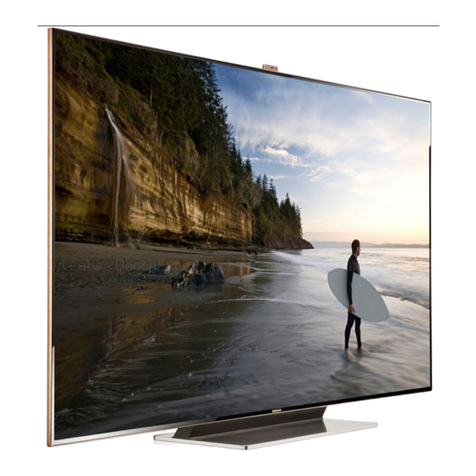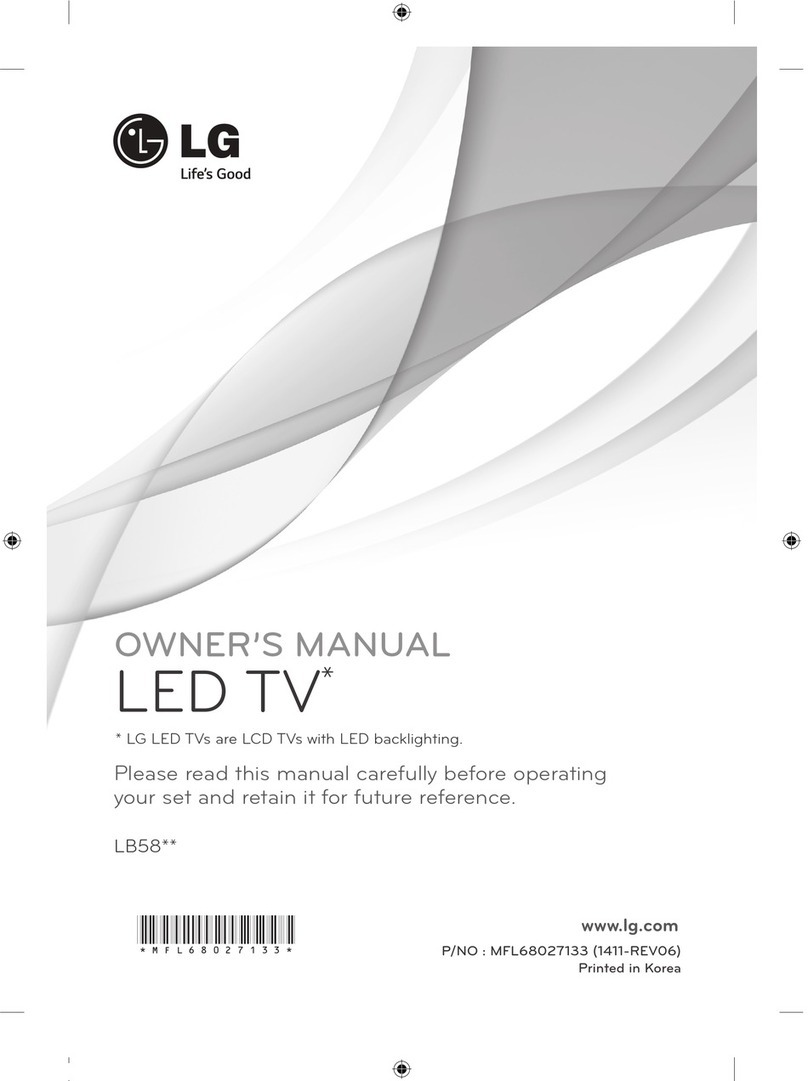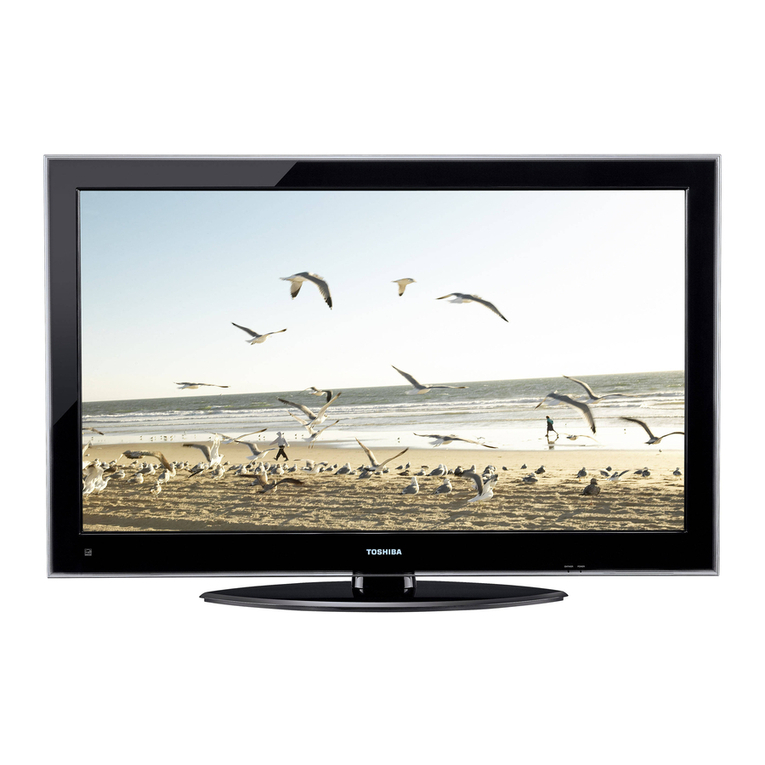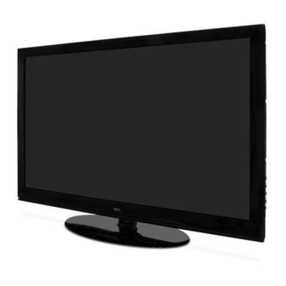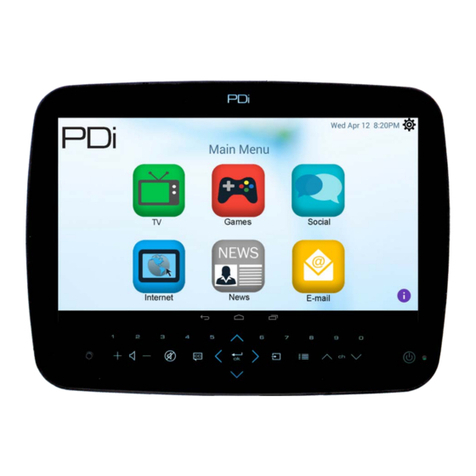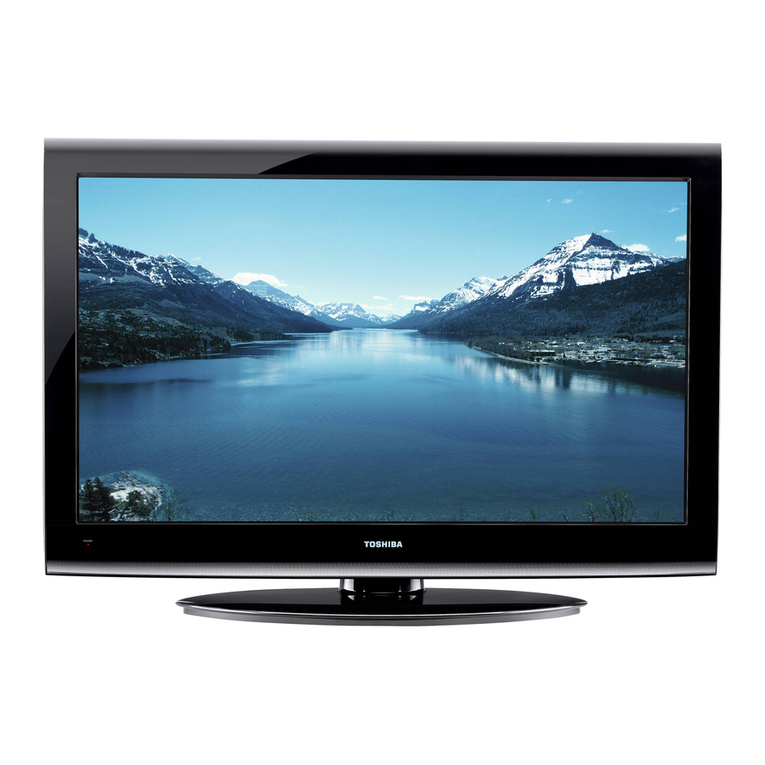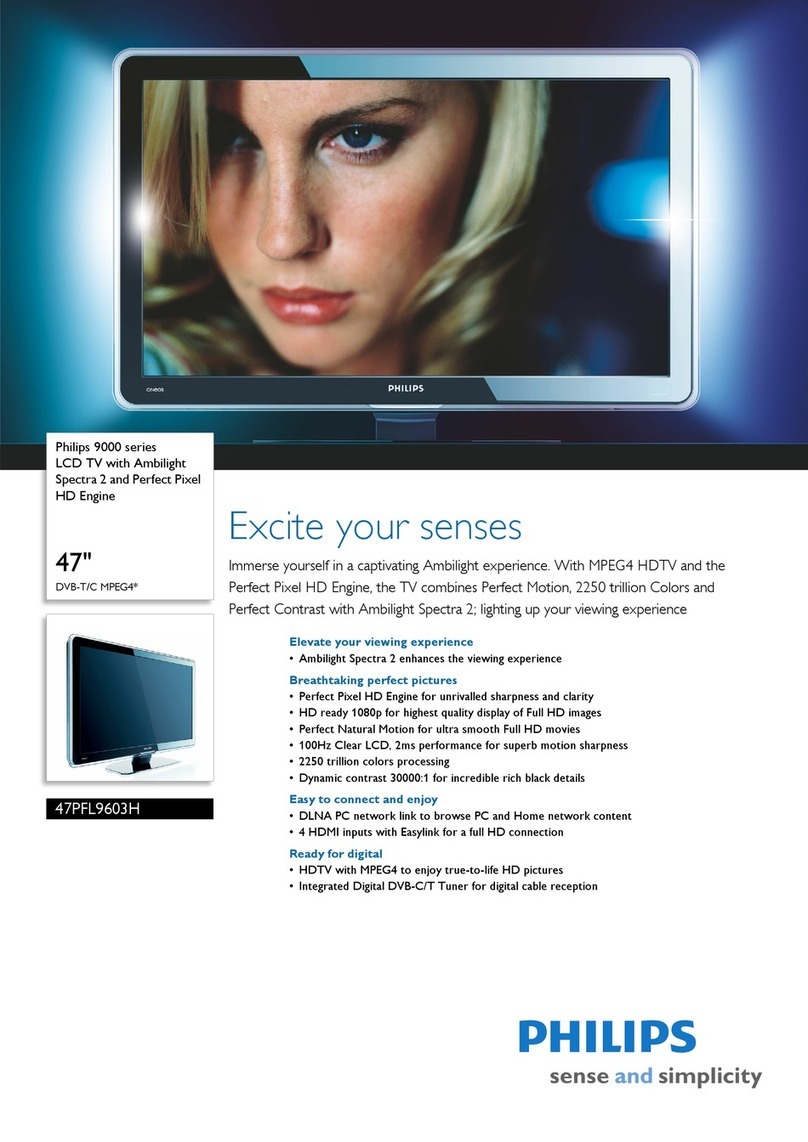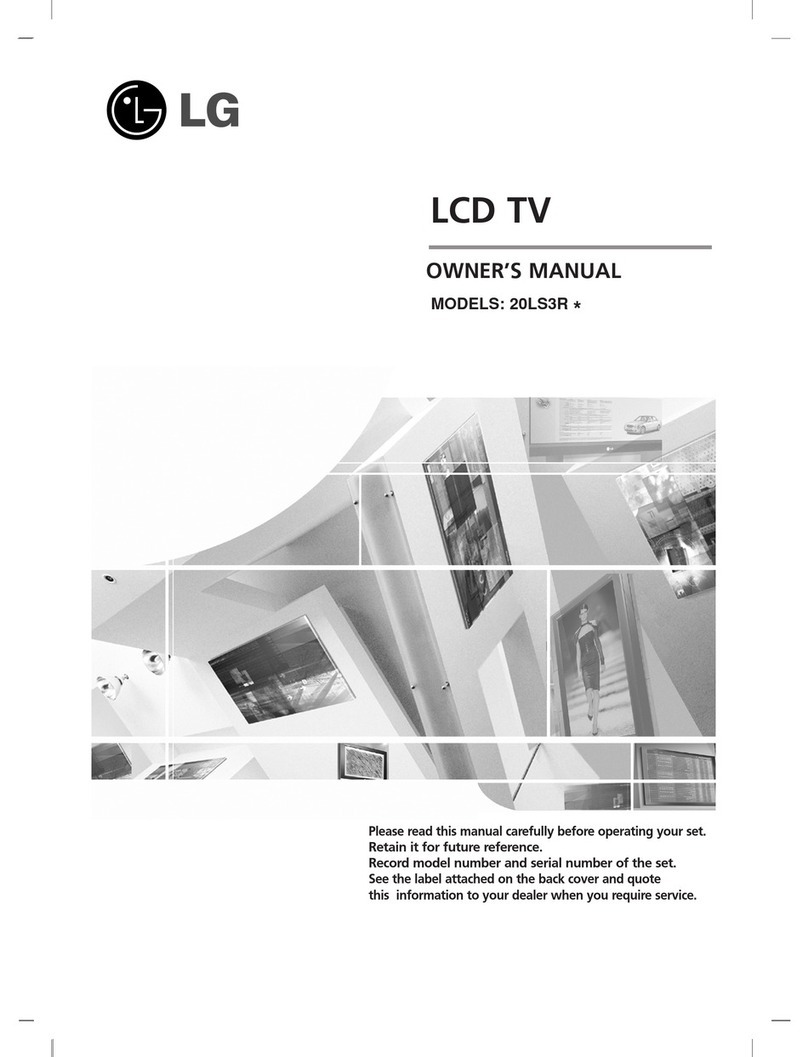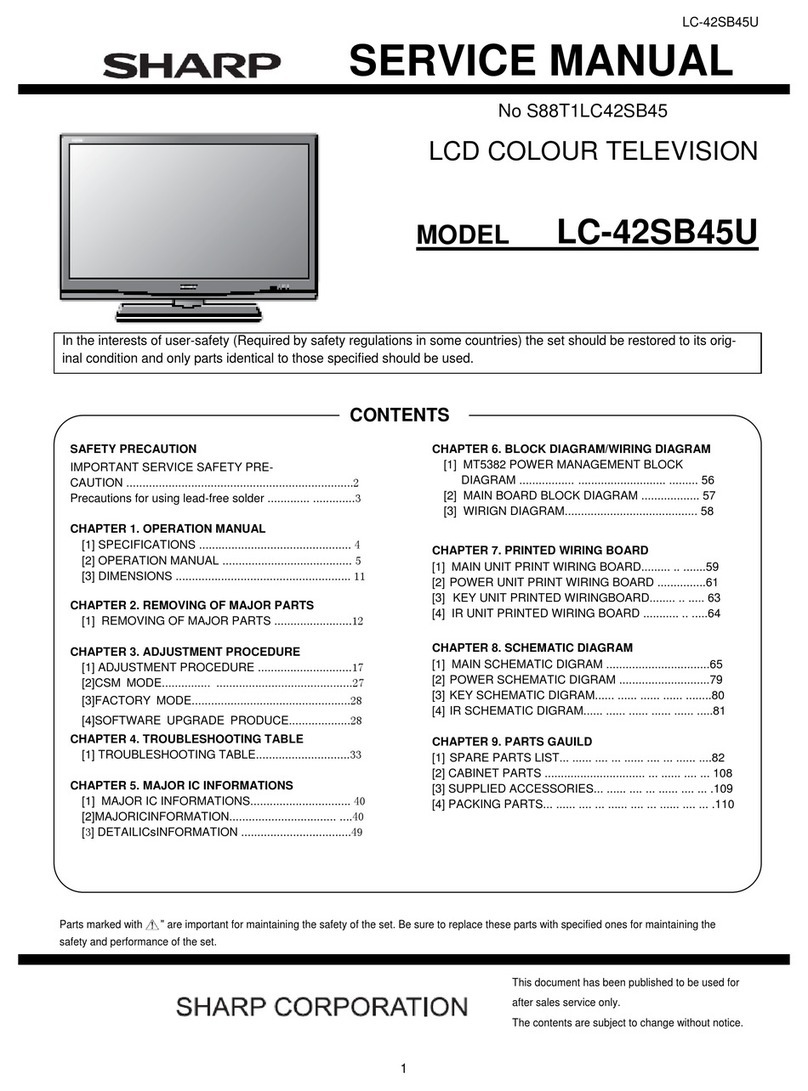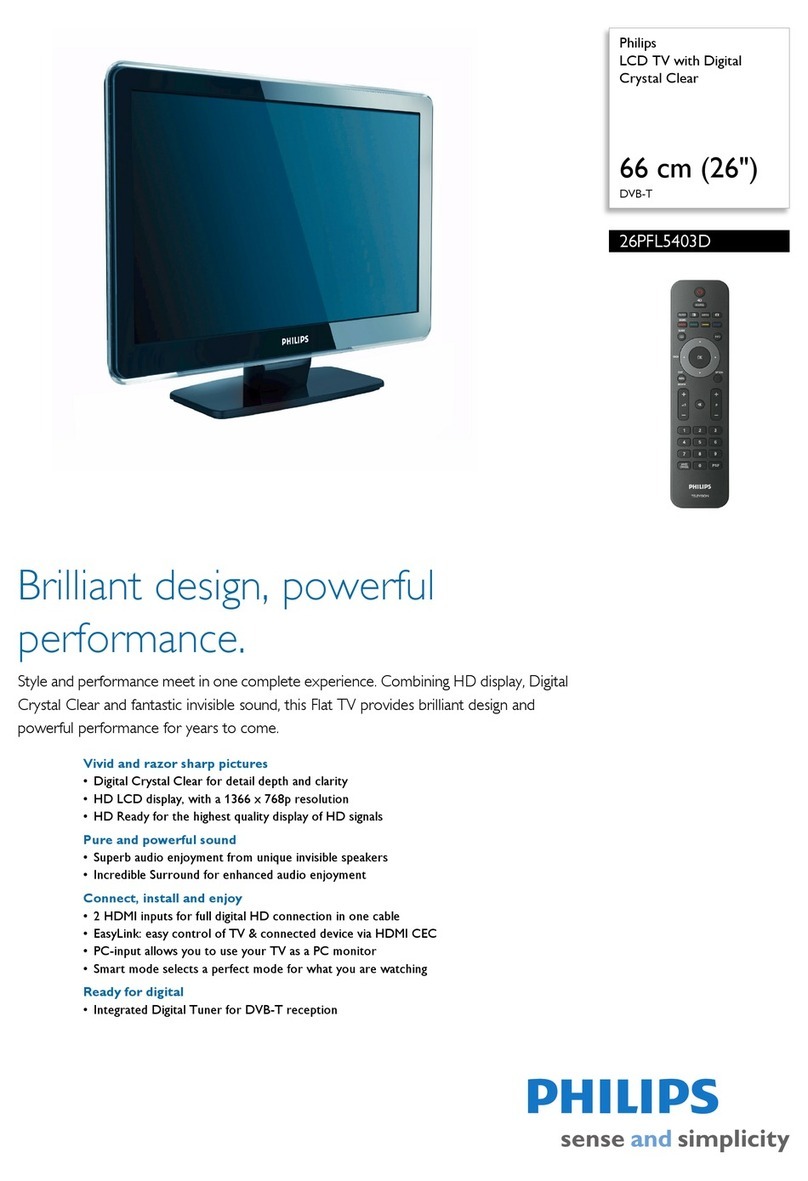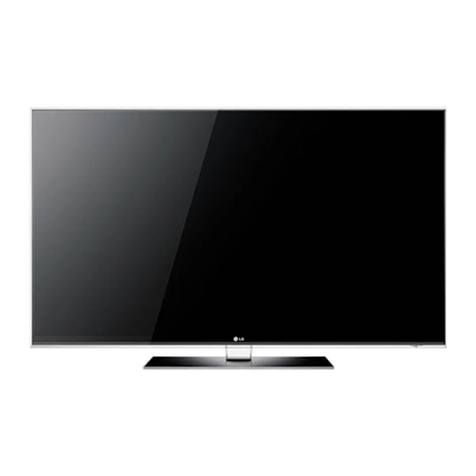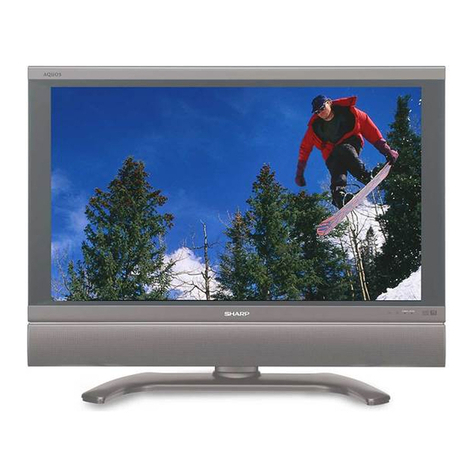Proview PA-32JK1A User manual


©2006 by Proview®. All rights reserved.
Copyright protection claimed includes all forms and matters of copyrightable material and
information now allowed by statutory judicial law or hereinafter granted, including without
limitation, material generated from the software programs which are displayed on the screen
such as icons, screen displays, looks, etc.
All Proview® product names mentioned in this publication are trademarks of Proview. Other
company trademarks are also acknowledged.
Changes are periodically made to this document. Changes, technical
inaccuracies, and typographic errors will be corrected in subsequent editions.
This TV incorporates High-Denition Multimedia Interface(HDMITM) technology.
HDMI, the HDMI logo and High-Denition Multimedia Interface are trademarks or registered
trademarks of HDMI Licensing LLC.

ENGLISHENGLISH
1
FCC
Federal Communications
Commission Statement
This equipment has been tested and found to comply with the limits of a class B digital device,
pursuant to Part 15 of the FCC Rules. These limits are designed to provide reasonable protection
against harmful interference in a residential installation. This equipment generates, uses and can
radiate radio frequency energy and, if not installed and used in accordance with the instructions, may
cause harmful interference to radio communications. However, there is no guarantee that
interference will not occur in a particular installation. If this equipment does cause harmful
interference to radio or television reception, which can be determined by turning the equipment off
and on, the user is encouraged to try to correct the interference by one or more of the following
measures:
1. Reorient/Relocate the receiving antenna.
2. Increase the separation between the equipment and receiver.
3. Connect the equipment into an outlet on a circuit which is different from what the receiver is
connected to.
4. Consult the dealer or an experienced radio/TV technician for help.
Changes or modifications not expressly approved by the manufacturer
responsible for compliance could void the user authority to operate the
equipment.

2
Warnings and Precautions
Warnings and Precautions
To reduce the risk of re or electric shock, do not expose this equipment to rain or moisture.
This symbol is intended to alert the user to avoid the risk of electric shock.
This equipment must not be disassembled by anyone except qualied service personnel.
This symbol is intended to alert the user to the presence of important operating and
maintenance instructions in the literature accompanying the appliance.
▪ TO REDUCE THE RISK OF ELECTRIC SHOCK,
▪ DO NOT REMOVE COVER (OR BACK).
▪ NO USER-SERVICEABLE PARTS INSIDE.
▪ REFER SERVICING TO QUALIFIED SERVICE PERSONNEL.
Use of controls, adjustments or performance of procedures other than those specied herein
may result in hazardous radiation exposure.
CAUTION
Important Safety Instructions
To prevent any injuries, the following safety precautions should be observed in the installation, use,
servicing and maintenance of this equipment.
Before operating this equipment, please read this manual completely, and keep it nearby for future
reference.
WARNING
▪ Do not place the equipment on any uneven or unstable carts, stands, tables, shelves etc.
The equipment may fall, causing serious injury to children or adults and serious damage to
the equipment itself.
▪ Use only a cart or stand recommended by the manufacturer. This equipment and
recommended cart or stand should be handled with care. Quick stops, excessive force, and
uneven surfaces may cause the equipment and cart/stand to overturn.
▪ Do not disable the 3-wire grounding type plug. The grounding pin on the 3-prong plug is an
important feature. Removing the grounding pin will increase the risk of damaging the
equipment.
▪ If you can not t the plug into the electrical outlet, contact an electrician to install a grounding
outlet.
▪ Always operate this equipment from the type of power source indicated on the rear of the
serial/model information label.
▪ Never overload wall outlets and extensions.
This symbol indicates caution points.
This symbol indicates actions that should not be done.
This symbol indicates actions that must be performed.

ENGLISHENGLISH
3
Warnings and Precautions
▪ Use and handle the power cord with care. Do not place any heavy objects on the AC
power cord.
▪ Do not pull the AC power cord. Do not handle the AC power cord with a wet hand.
▪ Do not touch the power cord and antenna cable during lightning.
▪ Remove the plug from the wall outlet, if the equipment will not be used for a long period
of time.
▪ Do not place, use or handle this equipment near water.
▪ Never expose the equipment to liquid, rain, or moisture.
Seek for service if any of the above is spilled into the equipment.
▪ Do not expose the equipment to extreme temperature or to direct sunlight, as the
equipment may heat up and suffer damage.
▪ Do not install the equipment near any heat sources such as radiators, heat registers,
stoves, or any other apparatus that might produce heat.
▪ Do not attempt to service the equipment yourself.
▪ Opening and removing the covers may expose you to dangerous voltage or other
hazards and may void your warranty. Refer service to qualied personnel.
▪ Do not place or drop any other objects on top.
▪ Do not insert anything into the ventilation holes of your equipment.
Inserting any metal or ammable objects may result to re or electric shock.
▪ Do not place the equipment on uneven or unstable carts, stands, tables, shelves etc. The
equipment may fall, causing serious injury to children or adults and serious damage to
the equipment itself. Always place the equipment on the oor or on a surface that is
sturdy, level, stable and strong enough to support the weight of the equipment.
▪ Do not block any ventilating openings. Leave an open space around the equipment.
Never place the equipment :
on a bed, sofa, rug, or any other similar surfaces; too close to drapes/curtains/walls, in a
bookcase, built-in cabinet, or any other similar places that may cause poor ventilation.
▪ Unplug this apparatus during lightning storms or when unused for long periods of time.
▪ Refer all servicing to qualified service personnel. Servicing is required when the
apparatus has been admaged in any way, such as power-supply cord or plug is
damaged, liquid has been spilled or objects have fallen into the apparatus, the apparatus
has been exposed to rain or moisture, does not operate normally, or has been dropped.
▪ Always remove the power cord from the outlet before cleaning the equipment.
▪ Never use liquid or aerosol cleaners on the equipment.
Clean only with a soft dry cloth.
▪ Only use attachments/accessories specified by the manufacturer.

4
Warnings and Precautions
Outdoor Antenna Safety Instructions
Antenna lead-in wire
Antenna discharge unit
(NEC section 810-20)
Grounding conductors
(NEC section 810-20)
Ground clamps
Power service grounding
(NEC Art250 part H)
Ground clamps
Electric service
equipment
NEC : National Electrical code
If an outdoor antenna is connected, follow the precautions below:
EXAMPLE OF OUTDOOR ANTENNA GROUNDING
Section 810 of National Electrical Code (NEC) provides information with respect to proper grounding of the
mast and supporting structure, grounding of the lead-in wire to an antenna discharge unit, size of grounding
conductors, location of antenna discharge unit, connection to grounding electrodes, and requirements for
the grounding electrode.
▪ An outdoor antenna should not be located in any area where it could come in contact with
overhead power lines, or any other electric light or power circuits.
▪ When installing an outdoor antenna system, extreme caution should be taken to prevent
contact with power lines. Direct contact with power lines may be fatal and should be avoided
at all costs.

ENGLISHENGLISH
5
CONTENTS
Federal Communications Commission Statement
...........................................................................................................................................1
Warnings and Precautions
Important Safety Instructions....................................................................................... 2
Antenna Safety Instructions......................................................................................... 4
Chapter 1 Introducing the LCD TV
Key Features ............................................................................................................... 6
Package Contents ....................................................................................................... 7
Setting Your LCD TV.................................................................................................... 8
Your LCD TV...............................................................................................................11
Your Remote Control ................................................................................................. 13
Chapter 2 Installing the LCD TV
Connecting a TV Cable or an Antenna ...................................................................... 15
Connecting a VCR..................................................................................................... 19
Connecting a Video Camera or Game Console......................................................... 20
Connecting a DVD Player.......................................................................................... 21
Connecting a Digital TV Cable Box or Digital Satellite Receiver ............................... 23
Connecting an AV Equipment with HDMI Connector................................................. 24
Connecting an AV Equipment with DVI Connector .................................................... 25
Connecting a PC........................................................................................................ 26
Connecting an Audio Receiver or a Dolby Digital 5.1 Sound System........................ 27
Chapter 3 USING THE FEATURES
Using Picture-In-Picture...................................................................................28
Wide Screen Viewing ......................................................................................30
Operating the Menu........................................................................................31
Setting up the HDTV Function ..........................................................................33
Customizing the VIDEO Settings ......................................................................37
Customizing the AUDIO Settings ......................................................................39
Customizing the SETUP Settings..................................................................... 40
Using the V-CHIP Settings...............................................................................42
Using the Parental Settings..............................................................................44
Customizing the TV Settings............................................................................45
TroubleShooting
......................................................................................................................................... 46
Speciction
......................................................................................................................................... 48

6
Chapter 1 Introducing the LCD TV
Various Audio/Video terminals for external equipment connection
▪ 2 set of composite A/V input terminals
▪ 1 set of S-VIDEO terminals
▪ 2 set of component Video input terminals
▪ 1 VGA/ Audio input terminal
▪ 2 HDMI/Auido input terminals
▪ 1 sets of Audio(L/R) output terminals
▪ 2 SPDIF output terminals (Optical x 1 /Coaxial x 1)
▪ 1 Headphone terminal
The built-in TV tuner to receive HD ATSC
▪ This function allows the reception of HD broadcasting without the addition of a set top
box.
High Definition Multimedia Interface (HDMI)
▪ High Denition Multimedia Interface (HDMI) is a small, user-friendly interconnect that
can carry up to 5 Gbps of combined video and audio in a single cable. This system
eliminates the cost, complexity and confusion of multiple cables used to connect
current A/V systems.
Precise Touch Control Buttons
▪ The Precise Touch Control Buttons is a touch-sensitive technology to replace the
conventional buttons.
HDTV Component Video Inputs
▪ Offers the best video quality for DVD(480p) and digital set-top-box (HD: 720p, 1080i)
connections.
3D Digital Noise Reduction
▪ This function can digitally reduce image noise to provide better picture quality.
Film-Mode Detection (3:2 Reverse Pull Down)
▪ This function can automatically detect content derived from lm and adjust the
interlacer’s frame matching to provide a more natural-looking, clearer image of the
moving picture.
PIP Function
▪ Provides viewing of two programs simultaneously, in either picture-in-picture mode or
picture-on-picture (side by side) mode.
Chapter 1
Introducing the LCD TV
Key Features

ENGLISH
7
Chapter 1 Introducing the LCD TV
þ LCD TV
Make sure all of the following contents are included.
These items are all you need to set up and operate the LCD TV in its basic configuration.
Package Contents
þ
VIDEO Cable
þ
Power Cord
þ
AUDIO Cable
þ
Remote Control/
AAA Batteries x 2
þ Quick Guide þ User’s Guide
þ Warranty Card þ Attention Card
CH CHVOL.- VOL.+ MENU SOURCE /I
OK
POWER
GUIDEEXIT
INFO
LISTFAV.CHTIMERFREEZE
MENU
S.MODE
SLEEP
SWAPPIP
P.MODE
MTSMUTE
CAPTIONP.SIZE
123
456
789
JUMP
0
.
VOL.CH.
AIR/CABLE
SOURCE
Most devices (VCRs, DVD player, etc.) come with the necessary cable for
connection. If you want to set up a complex system, you may need to buy
extra cable, connector, etc.
1-877-532-81 76, Monday thruF riday 8:00 am to 6:0 0pm (PST )
Toobtain cu stomer servi ce and techn ical supportby phone:
7373 Hun tA ve.
Please call (1-877 - 53 2-8176)to loc at e yo ure neares t
þ
þ
þ

8
Chapter 1 Introducing the LCD TV
Follow the instructions below to install the TV stand:
Open the box, and make sure all necessary parts are in the box.
The package contains:
Setting Up Your LCD TV
How to install the TV Stand
LCD TV
Stand
Speaker
Screws(10)/
Screwdriver
Cover an even stable surface with a soft cloth. Place the LCD TV unit face-down on the
cloth.

ENGLISH
9
Chapter 1 Introducing the LCD TV
If you prefer to mount your LCD TV on a wall instead of attaching it to the
stand, please reference the instructions included in the wall mounting kit
(not included).
Hold the TV stand and place it on the six screw holes on the back of the unit as shown. Use
the screwdriver to tighten the six screws on the rear of the speaker until the screw is rmly
xed in place.
Fit the speaker onto the back of the display unit as shown below. Use the screwdriver to
tighten the four screws on the rear of the speaker until the screw is rmly xed in place.
Adjust the stand to your desired angle. The stand angle can be rotated 30Oto the right and
left.
CH CHVOL.- VOL.+ MENU SOURCE /I
completed
30o
30o

10
Chapter 1 Introducing the LCD TV
Do not use caustic cleaners (porcelain, stainless steel, toilet, or oven cleaner
etc.) on the remote, as it may suffer damage.
Use an antenna cable to connect the VHF/UHF signal to the LCD TV’s ANT. terminal
(refer to page18).
Connect the AC power cord at the back of the TV and connect the power cord to wall outlet.
Insert the 2 batteries supplied in remote control.
Connect other an external A/V device (refer to page 19-27).
Step1 Slide the back cover up to open the
battery compartment of the remote
control.
Step2 Insert two AAA size batteries.
Make sure to match the (+) and
( - ) ends of the batteries with
the (+) and ( - ) ends indicated
in the battery compartment.
Slide the cover back into place.
How to setup the TV

/I
ENGLISH
11
Chapter 1
Introducing the LCD TV
CH CHVOL.- VOL.+ MENU SOURCE /I
Your LCD TV
VOL +/-
Adjusts the volume up and down.
Selects the main-menu item and change
values for items when in the OSD mode.
CH
Scans up and down through channels.
Selects sub-menu item when in the OSD mode.
Front/Right Side View and Controls
EARPHONE
Connects to the external
headhone for private
listening.
VIDEO1 IN
Connects to the
composite Video and
Audio output jacks on
external video equipment.
Front View
R
L
AUDIO
VIDEO
Right Side View
LED
The LED light indicates when the LCD TV is activated.
SOURCE
Chooses from different input signal sources.
MENU
Press once to display the OSD (on
screen display), press again to turn the
OSD off.
/ I
Turns the LCD TV on and into standby mode.
IR
Infrared Receiver
R
L
AUDIO
VIDEO

HDMI1 IN HDMI2 IN
AUDIO
L R L R L R
L R
L
R
L R
L R
AUDIO
VGA IN
VIDEO2 IN
VIDEO AUDIO
S-VIDEO IN
S-VIDEO AUDIO
YPbPr1 IN
AUDIO OUT
STEREO DIGITAL
OPTICAL
COAXIAL
TV
CABLE
HDTV
AIR
VHF/UHF IN
Y Pb Pr AUDIO
YPbPr2 IN
Y Pb Pr AUDIO
12
Chapter 1 Introducing the LCD TV
Rear View and Jacks
VHF/UHF IN-TV-CABLE
Connects RF input from VHF/UHF antenna or cable.
VGA IN
Connects the PC, or other AV equipment with VGA and AUDIO(L/R)
output jacks.
YPbPr1 IN/YPbPr2 IN
Connects to the DVD player, Digital Set-Top-Box, or other AV
equipment with component(YPbPr) video and audio output jacks.
VIDEO2 IN
Connects to the composite VIDEO and AUDIO(L/R) output jacks on external video equipment.
AC IN
Connects to the AC power cord.
AUDIO OUT-STEREO
Connects to the AUDIO(L/R) input jacks on AV equipment.
AUDIO OUT-DIGITAL-OPTICAL/COAXIAL
Connects to the OPTICAL AUDIO jack on the digital/standard 5.1 audio system.
VHF/UHF IN-HDTV-AIR
Connects RF input from VHF/UHF antenna or cable to receive high/standard denition television.
S-VIDEO IN
Connects to the S-VIDEO and AUDIO(L/R) output jacks on external
video equipment.
HDMI1 IN/ HDMI2 IN
Connects the all digital AV equipment with HDMI connector.HDMI supports enhanced, high-
denition video and two-channel digital audio. The AUDIO(L/R) of HDMI IN is for DVI connection.

ENGLISH
13
Chapter 1 Introducing the LCD TV
OK
POWER
GUIDE EXIT
INFO
LIST F AV.CH TIMER FREEZE
MENU
S.MODE
SLEEP
SWAP PI PP.MOD E
MTS MUT E
CAPTI ON P.SIZE
1 2 3
456
78 9
JUMP 0.
VOL. CH.
AIR/CABLE
SOURCE
Your Remote Control
POWER Turns the LCD TV on and off
SWAP Swaps between
the main and sub
window in PIP/POP mode
P.MODE Selects picture mode: Vivid/Standard/
Cinema/Sport/User
PIP Turns PIP/POP on and off
MTS Cycles through the multi-channels TV
sound(MTS) options: SAP/MONO/
STEREO
S.MODE Selects
sound
effect options: Surround/
Live/Dance/Techno/Classic/Soft/Rock/
Pop/Off
MUTE Mutes and restores the audio
CAPTION Cycles through the Closed Caption:
OFF/CC1/CC2/CC3/CC4/TT1/TT2/TT3/
TT4/Off
SLEEP Cycles through the LCD TV sleep timer:
OFF/30/60/90/120 mins
P-SIZE Cycles through Wide mode settings:
NORMAL/FULL/WIDE/ZOOM
0-9 Select and switch to a channel by using
0-9 buttons
ŸIn HDTV mode, use with 0-9 and Ÿ
buttons to select a digital channels
JUMP Returns to previously selected channel
AIR/CABLE Cycles through the TV receiving signal:
AIR: antenna
Cable: STD/IRC/HRC
VOL.+- Increases and decreases volume
CH. Scans up and down the channels
SOURCE Pressing SOURCE to display a source list,
use buttons to select the video
equipment connected to the video inputs
of your LCD TV: TV/HDTV/VIDEO1/
VIDEO2/VIDEO3/VIDEO4/VIDEO5/
VIDEO6/VIDEO7/COMPUTER
1
2
2
3
4
5
6
7
8
9
10
2
6
1
7
8
9
13
14
11
12
15
10
11
12
13
14
4
3
5
15
16
16

14
Chapter 1 Introducing the LCD TV
OK
POWER
GUIDE EXIT
INFO
LIST FAV.CH TIMER FREEZE
MENU
S.MODE
SLEEP
SWAP PIPP.MODE
MTS MUTE
CAPTION P.SIZE
1 2 3
456
78 9
JUMP 0.
VOL. CH.
AIR/CABLE
SOURCE
20
18
19
21
22
23
Effective range:
The remote can control the LCD TV from up to 5m away, if pointed directly at the receiver.
GUIDE
In HDTV mode, pressing GUIDE displays
the Program Guide on the screen
EXIT
Exits the OSD menu
▲▼►◄ Cycles through OSD options and
OK selects individual menu items. OK
conrms option settings
INFO
Pressing once displays a variety of
information such as the current channel
and the input source
MENU
Displays the OSD menu on the screen
For European TV system only
LIST
In HDTV mode, press LIST button to
display the received channel list
TIMER
Allows you to set up the time, program the
TV to turn on and off, and to tune to a
specific channel
17
18
19
20
21
17
26
25
24
22
23
24
25
26
▪ Time:
Select to set the current time by hour,
minute, second
▪ Start Time:
Select to set the time that you want
the TV to turn on
▪ Stop Time:
Select to set the time that you want
the TV to turn off
▪ Channel:
Select to set the specic channel
you want the TV to tune to when turned on
▪ Activate:
Select to turn on/off/once the timer
▪ Confirm:
Select to conrm
FREEZE Pressing FREEZE to freeze the current
picture, press again to restore the
picture.
FAV.CH Pressing FAV.CH to display favorite
channels.

ENGLISH
15
Chapter 2 Installing the LCD TV
Chapter 2
Installing the LCD TV
Refer to the owner’s manual of any external equipment to be connected.
When connecting any external equipment, do not connect any AC power cords to wall outlets
until all other connections are completed.
Antenna Connection
The antenna requirements for good color TV reception are more important than those for a black &
white TV reception. For this reason, a good quality outdoor antenna is strongly recommended.
The following is a brief explanation of the type of connection that is provided with the various antenna
systems.
75-ohm coaxial cable (round)
F-type connector
300-ohm twin-lead cable (flat)
■ A 75-ohm system is generally a round cable (not included) with F-
type connector that can easily be attached to a terminal without
tools.
■ A 300-ohm system is a flat twin-lead cable (not included) that can
be attached to a 75-ohm terminal through a 300-75-ohm adapter
(not included).
Connecting a TV Cable or an Antenna

16
Chapter 2 Installing the LCD TV
OUT IN
300-ohm twin-
lead cable
300-ohm twin-
lead cable
75-ohm
coaxial cable
UHF
Antenna
VHF
Antenna
Combiner
(not included)
A. Combination VHF/UHF antenna
300-ohm twin-
lead cable
75-ohm
coaxial cable
VHF/UHF
Antenna
VHF/UHF
Antenna
300/75-ohm adapter
(not included)
B. Separate VHF and/or UHF antennas
Use one of the following two diagrams when connecting an outdoor antenna.
A: Shows how to use a VHF/UHF combination outdoor antenna.
B: Shows how to use a separate VHF and/or UHF outdoor antenna.

ENGLISH
17
Chapter 2 Installing the LCD TV
This reminder is provided to call the CATV system installer’s attention to Article 820-40 of the
National Electrical Code (NEC) that provides guidelines for proper grounding and, in particular,
species that the cable ground shall be connected to the grounding system of the building
accurately, or as close to the point of cable entry as possible. Use of this TV for other than
private viewing of programs broadcasted on UHF, VHF or transmitted by cable companies for
the use of the general public may require authorization from the broadcast/cable company, and/
or program owner.
A
IN
B
OUT
Cable TV Line
2 set signal
splitter
(not included)
RF switch
(not included)
Cable TV converter/
descrambler
(not included)
Cable TV (CATV) Connection
■ The RF switch (not included) is required to provide two inputs (A and B). Setting
the RF switch to position A allows viewing of all unscrambled channels by using
the TV channel keys.
■Setting the RF switch to position B allows viewing of all scrambled channels via
the converter/descrambler by using the converter channel keys.
■ A 75-ohm coaxial cable connector is built into the set for easy hookup.
When connecting the 75-ohm coaxial cable to the set, connect the 75-
ohm cable into the ANT. terminal.
■ Some cable TV companies offer premium pay channels. Since the
signals of these premium pay channels are scrambled, a cable TV
converter/descrambler is generally provided to the subscriber by the
cable TV company.
This converter/descrambler is necessary for normal viewing of scrambled channels.
(Set your TV to channel 3 or 4, typically one of these channels is used. If this is unknown,
consult your cable TV company.)
For more specic instructions on installing cable TV, consult your cable TV company.
One possible method of connecting the coverter/descrambler provided by your cable TV
company is shown in the diagram below.
VHF/UHF IN

18
Chapter 2 Installing the LCD TV
METHOD A:
Use an antenna cable to connect the NTSC signal to the LCD TV’s TV CABLE
terminal.
METHOD B:
Use an antenna cable to connect the ATSC signal to the LCD TV’s
HDTV AIR terminal.
Connect the AC power cord at the back of the TV and connect the power cord to wall
outlet.
Press the button on the remote to turn on the LCD TV.
Always disconnect the LCD TV from the power outlet when the LCD TV will
not be used for a long period of time.
The button on the front panel is only used for switching the LCD TV into
standby, it does not disconnect the device from the main voltage. To
completely disconnect the main voltage, please remove the power plug from
the socket.
Press the SOURCE button on the remote to
display the Source List. Use the ▲▼ buttons to
select TV( METHOD A), or HDTV (METHOD
B), and press the OK button.
TV
CABLE
HDTV
AIR
VHF/UHF IN
A
B
Main:
TV(CABLE/AIR)
HDTV (CABLE/AIR)
VIDEO1 (SIDE)
VIDEO2 (REAR)
VIDEO3 (S-VIDEO)
VIDEO4 (YPbPr1)
VIDEO5 (YPbPr2)
VIDEO6 (HDMI1)
VIDEO7 (HDMI2)
COMPUTER (VGA)
TV
CABLE
HDTV
AIR
VHF/UHF IN
This manual suits for next models
6
Table of contents
Languages:
Other Proview LCD TV manuals




